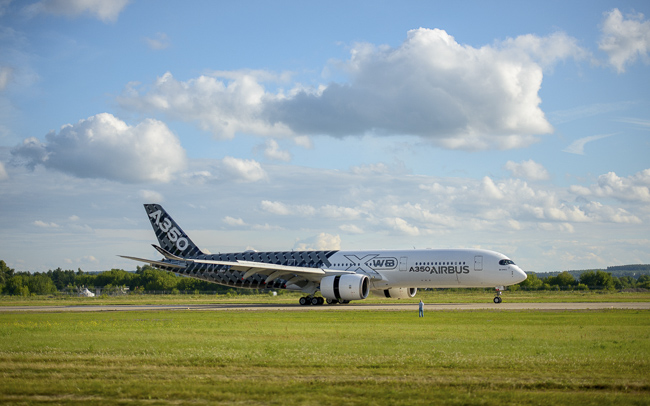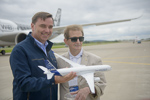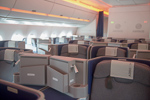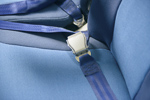A350-900 (MSN002) made its first flight on February 26, 2014. The aircraft has a distinctive carbon livery, which symbolises advanced technologies for the use of composite materials in the aircraft structure (more than 50%). On board there is a passenger cabin, as well as a "light" control and measuring equipment. This aircraft participated in certification tests related to the inspection of all aircraft cabin systems. At the moment the aircraft continues the program of test flights aimed at further improving the characteristics.
A350 XWB is a modern family of medium-range long-haul wide-bodied aircrafts (models A350-900, A350-1000). The aircraft of the A350 family are characterised by high economy and passenger comfort level. A350 XWB embodies all the most advanced technological achievements. Over 70% of the structure is made of high-tech materials, including composite materials - 53%, as well as titanium and aluminium alloys of the new generation.
An important aerodynamic feature of the A350 XWB is the profile of the wing with variable curvature: the wing of the aircraft is best adapted automatically for a specific phase of flight, reducing the resistance and thus reducing fuel consumption. The aircraft is equipped with engines of a new generation Rolls-Royce Trent XWB. These are the most efficient and environmentally friendly engines today. In addition, according to the manufacturer A350 XWB - the quietest twin-engine wide-body aircraft in the world. The level of external noise is 21 dB lower than the ICAO requirements (Chapter 4).
The air-conditioning system of A350 XWB is equipped with modern filters for high-efficiency air purification. The air in the passenger compartment is completely replaced every two minutes. There are 8 temperature zones on board, which allows to improve the temperature comfort. Also in the cabin is maintained a more comfortable pressure (corresponds to the pressure at an altitude of 1,800 m), so that passengers are less sensitive to its differences during take-off and landing. In addition, the air on board the A350 XWB is more humid, which is especially important for long flights.
The increased volume of overhead bins allows placing up to five standard suitcases in a row in each bin. The main zone of pilots' rest is located directly behind the cockpit of the pilots in the ceiling section. It is equipped with two beds, a table, a table and an entertainment system. The flight attendant's rest area is located in the tail section of the fuselage in the ceiling section. It is designed to accommodate six to seven people (it is possible to install up to eight beds).
Russian engineers from the ECAR engineering centre in Moscow took an active part in the creation of the A350 XWB: all design and strength calculations for the tail section of the fuselage, the cargo floor, the modules for the installation of systems and the interior of the cabin. Also, VSMPO-Avisma Corporation is the main supplier of titanium for the production of chassis and engine pylons. The share of titanium in the design of the aircraft is about 14%.
According to Airbus, the demand for A350 aircraft will be about 8100 units in the next 20 years. Important is the fact that the admission of pilots is the same for the A350 and A330. Therefore, 86% of A350 customers are A330 operators. At the moment 847 orders have been received from 45 customers. In operation there are 92 A350-900 in the park of 13 airlines: 15 Qatar Airways, 7 Vietnam Airlines, 7 LATAM, 10 Finnair, 15 Singapore Airlines, 16 Cathay Pacific, 5 Ethiopian Airlines, 4 Thai Airways, 6 China Airlines, 3 Lufthansa, 2 Air Caraïbes, 1 Asiana Airlines, 1 French Blue. The production rate of the A350 XWB is 10 aircrafts per month.
A350 XWB: specifications
|
|
A350-900
|
A350-1000
|
|
Capacity (3 classes)
|
325
|
366
|
|
Thrust of engines lbx1000
|
Trent XWB-84
84 (374 kN)
|
Trent XWB-97
97 (431 kN)
|
|
maximum take-off weight, ton
|
280
|
308
|
|
Range, km
|
15 000
|
14 723
|
|
Length, m
|
66,80
|
73,78
|
|
Wing span, m
|
64,75
|
|
|
Fuselage width, m
|
5,96
|
|
|
Height, m
|
17,05
|
17,08
|
|
Fuel capacity, l
|
141 000
|
156 000
|
Photoreport:




































































